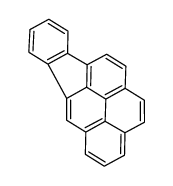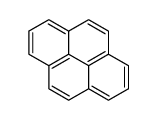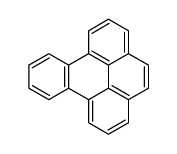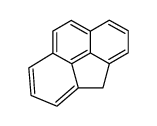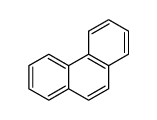1.Identification
1.1 GHS Product identifier
| Product name | Indeno[1,2,3-cd]pyrene |
|---|
1.2 Other means of identification
| Product number | - |
|---|---|
| Other names | 1,10-(o-Phenylene)pyrene |
1.3 Recommended use of the chemical and restrictions on use
| Identified uses | For industry use only. |
|---|---|
| Uses advised against | no data available |
1.4 Supplier's details
| Company | MOLBASE (Shanghai) Biotechnology Co., Ltd. |
|---|---|
| Address | Floor 4 & 5, Building 12, No. 1001 North Qinzhou Road, Xuhui District, Shanghai, China |
| Telephone | +86(21)64956998 |
| Fax | +86(21)54365166 |
1.5 Emergency phone number
| Emergency phone number | +86-400-6021-666 |
|---|---|
| Service hours | Monday to Friday, 9am-5pm (Standard time zone: UTC/GMT +8 hours). |
2.Hazard identification
2.1 Classification of the substance or mixture
Carcinogenicity, Category 2
2.2 GHS label elements, including precautionary statements
| Pictogram(s) |  |
|---|---|
| Signal word | Warning |
| Hazard statement(s) | H351 Suspected of causing cancer |
| Precautionary statement(s) | |
| Prevention | P201 Obtain special instructions before use. P202 Do not handle until all safety precautions have been read and understood. P280 Wear protective gloves/protective clothing/eye protection/face protection. |
| Response | P308+P313 IF exposed or concerned: Get medical advice/ attention. |
| Storage | P405 Store locked up. |
| Disposal | P501 Dispose of contents/container to ... |
2.3 Other hazards which do not result in classification
none
3.Composition/information on ingredients
3.1 Substances
| Chemical name | Common names and synonyms | CAS number | EC number | Concentration |
|---|---|---|---|---|
| Indeno[1,2,3-cd]pyrene | Indeno[1,2,3-cd]pyrene | 193-39-5 | none | 100% |
4.First-aid measures
4.1 Description of necessary first-aid measures
General advice
Consult a physician. Show this safety data sheet to the doctor in attendance.
If inhaled
Fresh air, rest.
In case of skin contact
Remove contaminated clothes. Rinse and then wash skin with water and soap.
In case of eye contact
First rinse with plenty of water for several minutes (remove contact lenses if easily possible), then refer for medical attention.
If swallowed
Rinse mouth. Refer for medical attention .
4.2 Most important symptoms/effects, acute and delayed
ACUTE/CHRONIC HAZARDS: Toxic.
4.3 Indication of immediate medical attention and special treatment needed, if necessary
Immediate First Aid: Ensure that adequate decontamination has been carried out. If patient is not breathing, start artificial respiration, preferably with a demand-valve resuscitator, bag-valve-mask device, or pocket mask, as trained. Perform CPR if necessary. Immediately flush contaminated eyes with gently flowing water. Do not induce vomiting. If vomiting occurs, lean patient forward or place on left side (head-down position, if possible) to maintain an open airway and prevent aspiration. Keep patient quiet and maintain normal body temperature. Obtain medical attention. /Aromatic hydrocarbons and related compounds/
5.Fire-fighting measures
5.1 Extinguishing media
Suitable extinguishing media
Suitable extinguishing media: Use water spray, alcohol-resistant foam, dry chemical or carbon dioxide.[Sigma-Aldrich; Safety Data Sheet for Indeno
5.2 Specific hazards arising from the chemical
Excerpt from ERG Guide 171 [Substances (Low to Moderate Hazard)]: Some may burn but none ignite readily. Containers may explode when heated. Some may be transported hot. For UN3508, be aware of possible short circuiting as this product is transported in a charged state. (ERG, 2016)
5.3 Special protective actions for fire-fighters
Wear self-contained breathing apparatus for firefighting if necessary.
6.Accidental release measures
6.1 Personal precautions, protective equipment and emergency procedures
Use personal protective equipment. Avoid dust formation. Avoid breathing vapours, mist or gas. Ensure adequate ventilation. Evacuate personnel to safe areas. Avoid breathing dust. For personal protection see section 8.
6.2 Environmental precautions
Sweep spilled substance into covered containers. If appropriate, moisten first to prevent dusting. Carefully collect remainder. Then store and dispose of according to local regulations. Do NOT let this chemical enter the environment.
6.3 Methods and materials for containment and cleaning up
ACCIDENTAL RELEASE MEASURES: Personal precautions, protective equipment and emergency procedures: Use personal protective equipment. Avoid dust formation. Avoid breathing vapors, mist or gas. Ensure adequate ventilation. Evacuate personnel to safe areas. Avoid breathing dust. Environmental precautions: Prevent further leakage or spillage if safe to do so. Do not let product enter drains. Methods and materials for containment and cleaning up: Pick up and arrange disposal without creating dust. Sweep up and shovel. Keep in suitable, closed containers for disposal.[Sigma-Aldrich; Safety Data Sheet for Indeno
7.Handling and storage
7.1 Precautions for safe handling
Avoid contact with skin and eyes. Avoid formation of dust and aerosols. Avoid exposure - obtain special instructions before use.Provide appropriate exhaust ventilation at places where dust is formed. For precautions see section 2.2.
7.2 Conditions for safe storage, including any incompatibilities
Provision to contain effluent from fire extinguishing. Well closed.Keep container tightly closed in a dry and well-ventilated place. Storage class (TRGS 510): Non Combustible Solids.[Sigma-Aldrich; Safety Data Sheet for Indeno
8.Exposure controls/personal protection
8.1 Control parameters
Occupational Exposure limit values
Recommended Exposure Limit: 10 Hr Time-Weighted Avg: 0.1 mg/cu m (cyclohexane-extractable fraction). /Coal tar pitch volatiles/
NIOSH considers coal tar pitch volatiles to be potential occupational carcinogens. NIOSH usually recommends that occupational exposures to carcinogens be limited to the lowest feasible concentration. /Coal tar pitch volatiles/
Biological limit values
no data available
8.2 Appropriate engineering controls
Handle in accordance with good industrial hygiene and safety practice. Wash hands before breaks and at the end of workday.
8.3 Individual protection measures, such as personal protective equipment (PPE)
Eye/face protection
Safety glasses with side-shields conforming to EN166. Use equipment for eye protection tested and approved under appropriate government standards such as NIOSH (US) or EN 166(EU).
Skin protection
Wear impervious clothing. The type of protective equipment must be selected according to the concentration and amount of the dangerous substance at the specific workplace. Handle with gloves. Gloves must be inspected prior to use. Use proper glove removal technique(without touching glove's outer surface) to avoid skin contact with this product. Dispose of contaminated gloves after use in accordance with applicable laws and good laboratory practices. Wash and dry hands. The selected protective gloves have to satisfy the specifications of EU Directive 89/686/EEC and the standard EN 374 derived from it.
Respiratory protection
Wear dust mask when handling large quantities.
Thermal hazards
no data available
9.Physical and chemical properties
| Physical state | YELLOW CRYSTALS |
|---|---|
| Colour | Yellow crystals from cyclohexane; bright-yellow plates from petroleum ether |
| Odour | no data available |
| Melting point/ freezing point | 163.6ºC |
| Boiling point or initial boiling point and boiling range | 497.1ºC at 760 mmHg |
| Flammability | no data available |
| Lower and upper explosion limit / flammability limit | no data available |
| Flash point | 247.2ºC |
| Auto-ignition temperature | no data available |
| Decomposition temperature | no data available |
| pH | no data available |
| Kinematic viscosity | no data available |
| Solubility | In water, 6.9X10-4 umol/L (1.9X10-4 mg/L) at 25°C |
| Partition coefficient n-octanol/water (log value) | log Kow = 6.70 (est) |
| Vapour pressure | 0mmHg at 25°C |
| Density and/or relative density | 1.378 g/cm3 |
| Relative vapour density | no data available |
| Particle characteristics | no data available |
10.Stability and reactivity
10.1 Reactivity
no data available
10.2 Chemical stability
Stable under recommended storage conditions.[Sigma-Aldrich; Safety Data Sheet for Indeno
10.3 Possibility of hazardous reactions
IP itself burns only with difficulty.Vigorous reactions, sometimes amounting to explosions, can result from the contact between aromatic hydrocarbons, such as INDENO(1,2,3-CD)PYRENE, and strong oxidizing agents. They can react exothermically with bases and with diazo compounds. Substitution at the benzene nucleus occurs by halogenation (acid catalyst), nitration, sulfonation, and the Friedel-Crafts reaction.
10.4 Conditions to avoid
no data available
10.5 Incompatible materials
Incompatible materials: Strong oxidizing agents.[Sigma-Aldrich; Safety Data Sheet for Indeno
10.6 Hazardous decomposition products
Hazardous decomposition products formed under fire conditions - Carbon oxides.[Sigma-Aldrich; Safety Data Sheet for Indeno
11.Toxicological information
Acute toxicity
- Oral: no data available
- Inhalation: no data available
- Dermal: no data available
Skin corrosion/irritation
no data available
Serious eye damage/irritation
no data available
Respiratory or skin sensitization
no data available
Germ cell mutagenicity
no data available
Carcinogenicity
OVERALL EVALUATION: Group 2B: The agent is possibly carcinogenic to humans.
Reproductive toxicity
no data available
STOT-single exposure
no data available
STOT-repeated exposure
no data available
Aspiration hazard
no data available
12.Ecological information
12.1 Toxicity
- Toxicity to fish: no data available
- Toxicity to daphnia and other aquatic invertebrates: no data available
- Toxicity to algae: no data available
- Toxicity to microorganisms: no data available
12.2 Persistence and degradability
AEROBIC: In a 240 day soil microcosm study, half-lives of 600, 730, and 630 days at 10, 20, and 30°C, respectively, were estimated for indeno(1,2,3-cd)pyrene(1). Half-lives for indeno(1,2,3-cd)pyrene ranged from 730 days, using a synthetic mixture of polycyclic aromatic hydrocarbons applied and incubated together in Kidman sandy loam soil, to 139 days in a mixture of oil refinery wastes applied to Kidman sandy loam soil(2). A half-life of 288 days was observed for indeno(1,2,3-cd)pyrene when applied and incubated as a single constituent in Kidman sandy loam soil(2). Biodegradation half-lives of 288 and 289 days were observed for indeno(1,2,3-cd)pyrene in Kidman and McLaurin sandy loam soils, respectively(3). In soil-water slurry systems, with actual town gas soil, indeno(1,2,3-cd)pyrene was biodegraded approx. 33% after 5 weeks incubation using a polycyclic aromatic hydrocarbon- acclimated mixed culture(4). In bench-scale biotreatability studies using a solid-phase bioremediation process (land farming chambers containing sediment and soil collected from the American Creosote Works Superfund site, Pensacola, FL), the indeno(1,2,3-cd)pyrene concentration was reduced from 29.7 to 29.2 mg/land farming chamber in unamended surface soil; 29.7 to 24.3 mg/land farming chamber in nutrient-amended surface soil; 67.8 to 54.0 mg/land farming chamber in unamended sediment; and 67.8 to 47.4 mg/land farming chamber in nutrient-amended sediment following 12 weeks incubation(5). In shake flask studies, an initial indeno(1,2,3-cd)pyrene concentration of 1.9 ug/mL was reduced to 0.9 ug/mL following 2 weeks incubation in contaminated groundwater from the American Creosote Works Superfund site, Pensacola, FL(6). Indeno(1,2,3-cd)pyrene was removed up to 95% over 36 days in an activated sludge pilot reactor, 40-65% was attributed to biodegradation(7). After 60 days of batch slurry bioremediation, the initial solid-phase indeno(1,2,3-cd)pyrene concentration of 37 ug/g was reduced to 17.1 ug/g, a 53.8% removal(8).
12.3 Bioaccumulative potential
An estimated BCF of 12,000 was calculated in fish for indeno(1,2,3-cd)pyrene(SRC), using an estimated log Kow of 6.70(1) and a regression-derived equation(1). According to a classification scheme(2), this BCF suggests the potential for bioconcentration in aquatic organisms is very high(SRC), provided the compound is not metabolized by the organism(SRC). Polyaromatic hydrocarbons, including indeno(1,2,3-cd)pyrene, have been shown to be rapidly metabolized by some aquatic organisms(3). A BCF of approximately 1X10+4 was measured in the amphipod Rhepoxynius abronius after 10 days exposure to indeno(1,2,3-cd)pyrene(4). The biota-sediment accumulation factor (BSAF) for indeno(1,2,3-cd)pyrene determined using oligochaete worm (Lumbriculus variegatus) was 1.7 and 0.0094 in Lake Erie sediment from Vermilion, OH and Dunkirk, NY, respectively(5). The BSAF of indeno(1,2,3-cd)pyrene was measured in polychaete (Nereis diversicolor) and gastropod (Hinia reticulata) exposed to sediment from three harbors in Norway at 0.0022-0.010 and 0.008-0.016(6).
12.4 Mobility in soil
Using a structure estimation method based on molecular connectivity indices(1), the Koc of indeno(1,2,3-cd)pyrene can be estimated to be 1.9X10+6(SRC). According to a classification scheme(2), this estimated Koc value suggests that indeno(1,2,3-cd)pyrene is expected to be immobile in soil. Log Koc values of 6.84 to 6.88 and 6.8 were determined for indeno(1,2,3-cd)pyrene with dissolved and particulate organic material, respectively, from Lake Ketelmeer at 20°C(3). The log Koc value of indeno(1,2,3-cd)pyrene measured in sediment from San Francisco Bay was 6.93(4). The log Koc values for indeno(1,2,3-cd)pyrene in 34 sediment samples was 5.78-8.82(5). [
12.5 Other adverse effects
no data available
13.Disposal considerations
13.1 Disposal methods
Product
The material can be disposed of by removal to a licensed chemical destruction plant or by controlled incineration with flue gas scrubbing. Do not contaminate water, foodstuffs, feed or seed by storage or disposal. Do not discharge to sewer systems.
Contaminated packaging
Containers can be triply rinsed (or equivalent) and offered for recycling or reconditioning. Alternatively, the packaging can be punctured to make it unusable for other purposes and then be disposed of in a sanitary landfill. Controlled incineration with flue gas scrubbing is possible for combustible packaging materials.
14.Transport information
14.1 UN Number
| ADR/RID: UN2811 | IMDG: UN2811 | IATA: UN2811 |
14.2 UN Proper Shipping Name
| ADR/RID: TOXIC SOLID, ORGANIC, N.O.S. |
| IMDG: TOXIC SOLID, ORGANIC, N.O.S. |
| IATA: TOXIC SOLID, ORGANIC, N.O.S. |
14.3 Transport hazard class(es)
| ADR/RID: 6.1(b) | IMDG: 6.1(b) | IATA: 6.1(b) |
14.4 Packing group, if applicable
| ADR/RID: III | IMDG: III | IATA: III |
14.5 Environmental hazards
| ADR/RID: no | IMDG: no | IATA: no |
14.6 Special precautions for user
no data available
14.7 Transport in bulk according to Annex II of MARPOL 73/78 and the IBC Code
no data available
15.Regulatory information
15.1 Safety, health and environmental regulations specific for the product in question
| Chemical name | Common names and synonyms | CAS number | EC number |
|---|---|---|---|
| Indeno[1,2,3-cd]pyrene | Indeno[1,2,3-cd]pyrene | 193-39-5 | none |
| European Inventory of Existing Commercial Chemical Substances (EINECS) | Listed. | ||
| EC Inventory | Listed. | ||
| United States Toxic Substances Control Act (TSCA) Inventory | Listed. | ||
| China Catalog of Hazardous chemicals 2015 | Not Listed. | ||
| New Zealand Inventory of Chemicals (NZIoC) | Listed. | ||
| Philippines Inventory of Chemicals and Chemical Substances (PICCS) | Not Listed. | ||
| Vietnam National Chemical Inventory | Not Listed. | ||
| Chinese Chemical Inventory of Existing Chemical Substances (China IECSC) | Not Listed. | ||
16.Other information
Information on revision
| Creation Date | Aug 17, 2017 |
|---|---|
| Revision Date | Aug 17, 2017 |
Abbreviations and acronyms
- CAS: Chemical Abstracts Service
- ADR: European Agreement concerning the International Carriage of Dangerous Goods by Road
- RID: Regulation concerning the International Carriage of Dangerous Goods by Rail
- IMDG: International Maritime Dangerous Goods
- IATA: International Air Transportation Association
- TWA: Time Weighted Average
- STEL: Short term exposure limit
- LC50: Lethal Concentration 50%
- LD50: Lethal Dose 50%
- EC50: Effective Concentration 50%
References
- IPCS - The International Chemical Safety Cards (ICSC), website: http://www.ilo.org/dyn/icsc/showcard.home
- HSDB - Hazardous Substances Data Bank, website: https://toxnet.nlm.nih.gov/newtoxnet/hsdb.htm
- IARC - International Agency for Research on Cancer, website: http://www.iarc.fr/
- eChemPortal - The Global Portal to Information on Chemical Substances by OECD, website: http://www.echemportal.org/echemportal/index?pageID=0&request_locale=en
- CAMEO Chemicals, website: http://cameochemicals.noaa.gov/search/simple
- ChemIDplus, website: http://chem.sis.nlm.nih.gov/chemidplus/chemidlite.jsp
- ERG - Emergency Response Guidebook by U.S. Department of Transportation, website: http://www.phmsa.dot.gov/hazmat/library/erg
- Germany GESTIS-database on hazard substance, website: http://www.dguv.de/ifa/gestis/gestis-stoffdatenbank/index-2.jsp
- ECHA - European Chemicals Agency, website: https://echa.europa.eu/

